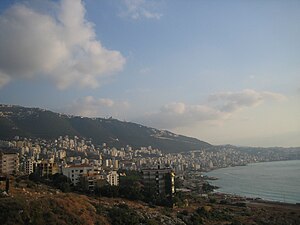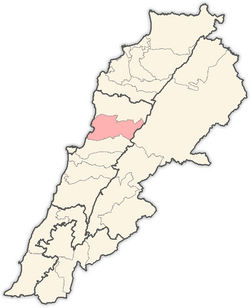Keserwan District (Arabic: قضاء كسروان, transliteration: Qaḍā' Kisrawān) is a district (qadaa) in Keserwan-Jbeil Governorate, Lebanon, to the northeast of Lebanon's capital Beirut. The capital, Jounieh, is overwhelmingly Maronite Christian. The area is home to the Jabal Moussa Biosphere Reserve.
Keserwan District
قضاء كسروان | |
|---|---|
District | |
 Jounieh Bay | |
| Motto: "The Christians' Castle" | |
 Location in Lebanon | |
| Country | |
| Governorate | Keserwan-Jbeil |
| Capital | Jounieh |
| Area | |
• Total | 336 km2 (130 sq mi) |
| Population | |
• Estimate (31 December 2017) | 182,834 |
| • Density | 544/km2 (1,410/sq mi) |
| Time zone | UTC+2 (EET) |
| • Summer (DST) | UTC+3 (EEST) |
Etymology
editAccording to the medieval historian Gabriel ibn al-Qilai, the name “Kesrwan” derives from the Maronite muqadam Kisra of Baskinta.[1] During the time of the Crusades, Keserwan was the northern frontier of the Kingdom of Jerusalem.
Demographics
editAs of 2022, the religious make-up of the District's 96,419 voters were roughly 82% Maronite Catholics, 5% Greek Catholic, 4% Greek Orthodox, 3% other Christian Minorities, 2% Shia, and 4% others.[2]According to voter registration data, the population is overwhelmingly Christian–the highest percentage-wise in the nation. [3]
Electoral constituency
editThe district is part of the Keserwan-Byblos electoral district, with the district of Keserwan being allocated 5 Maronite seats (and the overall constituency having 7 Maronites and 1 Shi'ia).
Cities, towns, and villages
edit- Aazra
- Adma
- Ain El Delbeh
- Ain el-Rihaneh
- Aintoura
- Ajaltoun
- Aramoun
- Ashqout
- Attine
- Ballouneh
- Batha
- Bekaata Ashqout
- Bekaata Kenaan
- Bezhel
- Bkerké
- Bouar
- Bqaatouta (Bkaatouta)
- Bzoummar
- Chahtoul
- Chnaniir
- Daraoun
- Daraya
- Dlebta
- Faitroun
- Faraya
- Fatqa
- Ghadir
- Ghbaleh
- Ghidras
- Ghineh
- Ghosta
- Harissa
- Hrajel
- Jdaidet Ghazir
- Jeita
- Jounieh
- Jouret Bedran
- Jouret Mhad
- Jouret el-Termos
- Jwar El Hous
- Kaslik
- Kfardebian
- Kfaryassine
- Kfour
- Kleiat
- Maarab
- Mayrouba
- Nammoura
- Okaibe
- Rayfoun
- Safra
- Sahel Alma
- Sarba
- Sehaileh
- Tabarja
- Wata El Jawz
- Yahchouch
- Zouk Mikael
- Zouk Mosbeh
Notable families
edit- Assaf dynasty Sultan Selim I assigned the Assafs as his chief agents in the region between Beirut and Tripoli, confirming their control of Keserwan, and awarding them tax farms in the nawahi of Byblos and Beirut.[4] While Emir Assaf had lived in Aintoura in the winter and elsewhere along the Nahr al-Kalb ridge prior to the Ottoman conquest, in 1517, he moved his headquarters to Ghazir. [5]
- Khazen family[6][7]
- Sfeir[8][9]
See also
editBibliography
edit- Crawford, Robert (April 1955). "William of Tyre and the Maronites". Speculum. 30 (2). The University of Chicago Press: 222–228. doi:10.2307/28448470. Retrieved 12 September 2024.
- Fahd, Butros (1974). Arciescovo Pietro Sfair grande orientalista e predicatore, vita e opere [Archbishop Pietro Sfair great orientalist and preacher, life and work] (in Italian). Rome: Matabi al-Karim al-Hadithath.
- Antoine Khoury Harb, The Maronites: History and Constants (ASIN B000B0F6NU)
- Matti Moosa, The Maronites in History (ISBN 1-59333-182-7)
- Richard Van Leeuwen, Notables and Clergy in Mount Lebanon: The Khāzin Sheikhs and the Maronite Church (1736-1840) (ISBN 90-04-09978-6)
- Farid el-Khazen, The Breakdown of the State in Lebanon, 1967-1976 (ISBN 0-674-08105-6)
- William Harris, Lebanon: A History, 600-2011 (ISBN 978-0-19-518111-1)
- Salibi, Kamal S. (1959). Maronite Historians of Medieval Lebanon. Beirut: American University of Beirut.
- Salibi, Kamal (June 1967). "Northern Lebanon under the Dominance of Ġazīr (1517–1591)". Arabica. 14 (2): 144–166. doi:10.1163/157005867X00029. JSTOR 4055631.
- Salibi, Kamal S. (1988). A House of Many Mansions: The History of Lebanon Reconsidered. University of California Press. ISBN 9780520071964.
- Catholic-Hierarchy
- The sword of the Maronite Prince
- Origins of the "Prince of Maronite" Title
- National Geographic Magazine DNA sample from Khazen member
- An Interview with Cheikh Malek el-Khazen
References
edit- ^ Salibi 1957, p. 5.
- ^ "Mapping Lebanon: Data and statistics".
- ^ دائرة جبل لبنان اﻻولى (PDF). Lebanese Elections (in Arabic). 2009. p. 2. Retrieved 10 March 2024.
- ^ Harris 2012, pp. 88–89.
- ^ Salibi 1967, p. 152.
- ^ Antoine Khoury Harb, The Maronites: History and Constants, p. 116. Quote: "When Prince Ahmad Maan died, the Shehabs, relatives of the Maan, took over. When the regent Prince Bashir I passed away in 1706, Prince Haidar reigned, and moved the seat of the emirate from Hasbaya to Deir el-Qamar. The Ottoman Wali of Sidon deposed the Shehabi Prince and replaced him by the leader of the Yamani party, Prince Yussef Alam - Eddin. Haidar fled with his two sons and some of his followers to Ghazir in Kisrawan where his allies, the Khazen and Hobeish families from the Qaysi party, were in control. When the army of Prince Yussef Alam-Eddin conquered and burnt Ghazir, Haidar left his sons in Kisrawan and took refuge in Hermel. The sheikhs of the Khazen family offered hiding-places to the prince's family."
- ^ Matti Moosa, The Maronites in History, p. 283. Quote: "We have also seen earlier that the Maronite community had been placed under the protection of France and that the French kings began to choose their consuls from among the Maronite dignitaries. Through the power and prestige of France the consuls then exercised authority over the Maronite Church and its clergy. The Maronites were so proud to be under the protection of France that some Maronites called themselves, 'the French of the East.' Thus, through France, the Shihabi amirs, who will be discussed shortly, realized the importance of Maronite rule and power, and they and the Maronites became united in a common interest. In 1697, Amir Ahmad died without an heir, and the Druze notables chose his nephew Bashir al-Shihabi as their new ruler. He was succeeded in 1707 by the young Amir Haydar al-Shihabi, grandson of Amir Ahmad al-Ma'ni. Haydar recognized the authority of the Maronite al-Khazins and the Hubayshis of Kisrawan and Ghazir and treated these two families as equal to the feudalistic Druze families." [1]
- ^ Fahd, Butros (1974). Arciescovo Pietro Sfair grande orientalista e predicatore, vita e opere [Archbishop Pietro Sfair great orientalist and preacher, life and work] (in Italian). Rome: Matabi al-Karim al-Hadithath.
- ^ Roberts, Sam (15 May 2019). "Cardinal Nasrallah Sfeir, 98, a Voice for Lebanese Christians, Dies". The New York Times.